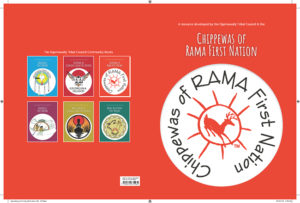The Ogemawahj Tribal Council enhance cultural resources for six First Nations

By Rick Garrick
CHIPPEWAS OF RAMA FIRST NATION—The Ogemawahj Tribal Council recently updated a series of books featuring governance, language, culture, community activities, history and the land in each of the member First Nations.
“We’ve been doing some work with our communities and our school boards updating a curriculum resource that was created in 2002,” says Greer Atkinson, education program/project coordinator with Ogemawahj Tribal Council. “So we did a project this year to update them and take them from 30 pages to 70 pages.”
Atkinson says the books were created in partnership with Nelson Canada. Each community helped with the project by providing updated information and images for the new books.
“The booklets give students an opportunity to look at how the First Nation communities right beside them are the same and yet different,” Atkinson says. “Some things run through each book, for instance our First Nations tend to acknowledge veterans more often than is done generally in Canada, we hear veteran songs at Pow Wows each summer and stand to honour them. We also tend to use humour more often and differently than other Canadians.”
Atkinson says language and education are key components in the books.
“These books showcase language champions in each community, featuring teachers and other people who are working hard at revitalizing Anishinaabemowin,” Atkinson says. “In the Rama booklet, several young people are featured for their passion, dedication and success at learning.”
Atkinson says each of the books have their own personality with information about different aspects of the communities.
“For instance, in Alderville, they have a really interesting monument that is dedicated to veterans, so we explored that,” Atkinson says. “And they have a unique partnership with local conservation authorities to develop and manage the environmentally sensitive Black Oak Savannah right on their territory, and they do quite a bit of land-based teaching on that.”
The Alderville War Monument soars about 50 feet high with three globes suspended from a cube symbolizing the four corners of the earth.
“In Georgina Island and Beausoleil, we [added to] their transportation sections because transportation is a huge issue for island communities,” Atkinson says. “[We] included new sections on the water and Water Walkers.”
Atkinson adds that the books include information about preparing wild rice and other foods, the difference in land ownership on reserve, and the complicated system of Indian status.
“And sometimes we are exploring individual successes,” Atkinson says. “[With] the Mississaugas of Scugog First Nation, we took some time to profile some incredible artists that have come from that community.”
Atkinson says the project included many meetings with people in the communities to gather updated information.
“In Moose Deer Point, we had a table where a few Elders came out and talked to us about what was important in their community,” Atkinson says. “They are at the end of Twelve Mile Bay and one of the biggest things to impact their community was getting a road in 1966. So we spent quite a bit of time talking about how that developed the community.”
The Ogemawahj Tribal Council is also working on creating a Companion Leaders Guide through funding from the Kinoomaadziwin Education Body (KEB).
“The Leaders Guide process involves having a few community members work with a few teachers from local schools to develop lesson plans that are based on the current book content and are aimed at Grades 3, 5 and 7,” Atkinson says. “The KEB is helping us with that second part to bring these books into the schools and really build the relationship between the First Nations and their local schools and school boards.”


